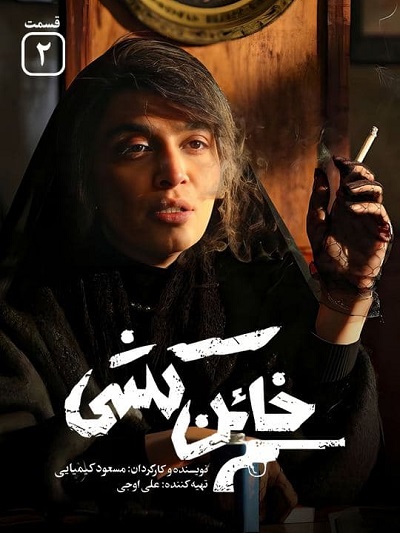Khaen Koshi 02

A group of patriotic and freedom-seeking individuals plan to carry out a bank heist operation targeting the National Bank. Their goal is to gather the necessary funds for the National Loan of Dr. Mohammad Mossadegh. However, not everything goes according to their plan…
Director
Masoud Kimiai
Cast
Ali Oji
Amir Aghaee
Amirreza Delavari
Andisheh Fooladvand
Elham Hamidi
Farhad Aeesh
Fariba Naderi
Hamidreza Azarang
Mehran Modiri
narges mohammadi
Pantea Bahram
Pardis Pourabedini
Poolad Kimiyaee
Reza Yazdani
Sam Derakhshani
Sam Noori
Sara Bahrami
Sepand Amirsoleimani
Shakib Shajareh
Danlod Va Pakhshe Online
The earliest examples of visual representations in Iranian history may be traced back to the bas-reliefs in Persepolis (c. 500 BC). Bas relief is a method of sculpting which entails carving or etching away the surface of a flat piece of stone or metal. Persepolis was the ritual center of the ancient kingdom of Achaemenids and “the figures at Persepolis remain bound by the rules of grammar and syntax of visual language.” Iranian visual arts may be said to have peaked about a thousand years later during the Sassanian reign. A bas-relief from this period in Taq Bostan (western Iran) depicts a complex hunting scene. Similar works from the period have been found to articulate movements and actions in a highly sophisticated manner. It is even possible to see the progenitor of the cinema close-up: a wounded wild pig escaping from the hunting ground, among these works of art. After the conversion from Zoroastrianism to Islam; Persian art continued its visual practices. Persian miniatures provide great examples of such continued attempts. The deliberate lack of perspective in Persian miniature enabled the artist to have different plots and sub-plots within the same image space. A very popular form of such art was Pardeh Khani. Another type of art in the same category was Naqqali. Popular dramatic performance arts in Iran, before the advent of cinema, include Marionette, Saye-bazi (shadow plays), Rouhozi (comical acts), and Ta’zieh. cinema entered into the public realm, but, its cultural and economic capabilities were still unknown. As a consequence, theaters experienced a growing trend at the outset as to reveal economic attractions of cinema. Due to equating him with the Iranian Constitutional Revolutionaries, Mirza Ebrahim Khan Sahhafbashi’s Kinetoscopes corridor didn’t last for even a month and was closed, resulting in his leaving Iran. Then, it was the turn of Rousi Khan’s public theater. It, too, didn’t survive for a long time as the public theater was plundered during conflicts between Mohammad Ali Shah and Constitution Revolutionaries and, moreover, he himself fled abroad. After him, it was‘ Ardeshir Khan Armeni’ who introduced the real meaning of running and using cinema, continuing until long after him.
Cinema was only five years old when it came to Persia at the beginning of the 20th century. The first Persian filmmaker was Mirza Ebrahim Khan Akkas Bashi, the official photographer of Muzaffar al-Din Shah, the King of Persia from 1896–1907. After a visit to Paris in July 1900, Akkas Bashi obtained a camera and filmed the Shah’s visit to Europe upon the Shah’s orders. He is said to have filmed the Shah’s private and religious ceremonies, but no copies of such films exist today. A few years after Akkas Bashi started photography, Khan Baba Motazedi, another pioneer in Iranian motion picture photography emerged. He shot a considerable amount of newsreel footage during the reign of Qajar to the Pahlavi dynasty. The first public screening took place in Tehran in 1904, presented by Mirza Ebrahim Khan Sahaf Bashi. He arranged the screening in the back of his antique shop. In 1905, Sahaf Bashi opened the first movie theater in Cheragh Gaz Avenue in the national capital. In 1909, with fall of the Mohammad Ali Shah Qajar heir of Mozaffar ad-Din Shah Qajar and the success of the constitutionalists, Russi Khan lost his support. Consequently, his film theatre and photography studios were destroyed by the public. Soon after, other cinema theatres in Tehran closed down. Movie theatres sprang up again in 1912 with the help of Ardeshir Khan, an Armenian-Iranian. In 1904, Mirza Ebrahim Khan Sahhafbashi opened the first movie theater in Tehran. The cinematographic camera was introduced to Iran in 1929, as yet another tool of modernization. After Mirza Ebrahim Khan, several others like Russi Khan, Ardeshir Khan, and Ali Vakili tried to establish new movie theaters in Tehran. Until the early 1930s, there were little more than 15 theatres in Tehran and 11 in other provinces. In 1925, Ovanes Ohanian, decided to establish the first film school in Iran. Within five years he managed to run the first session of the school under the name “Parvareshgahe Artistiye Cinema”.





